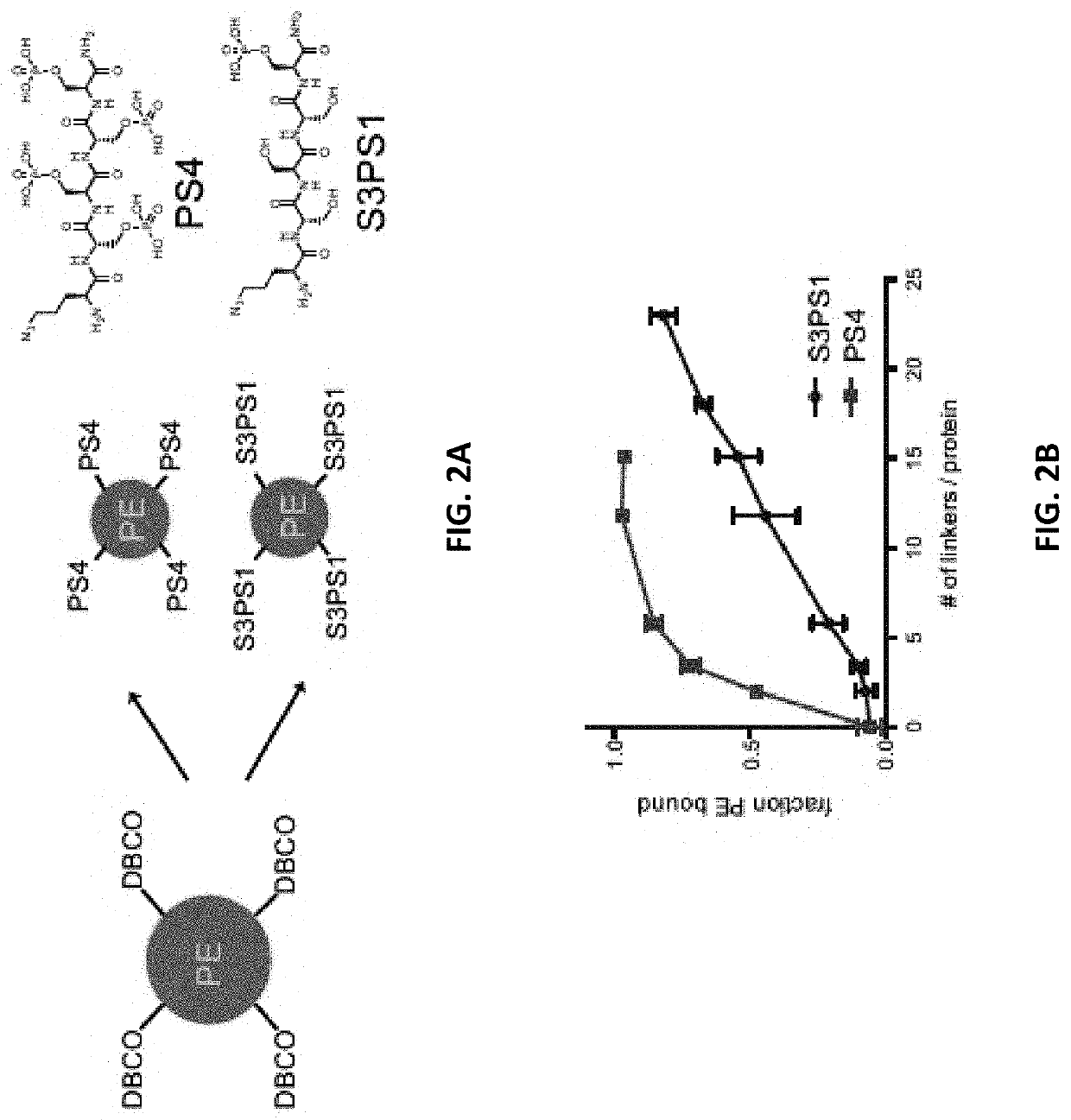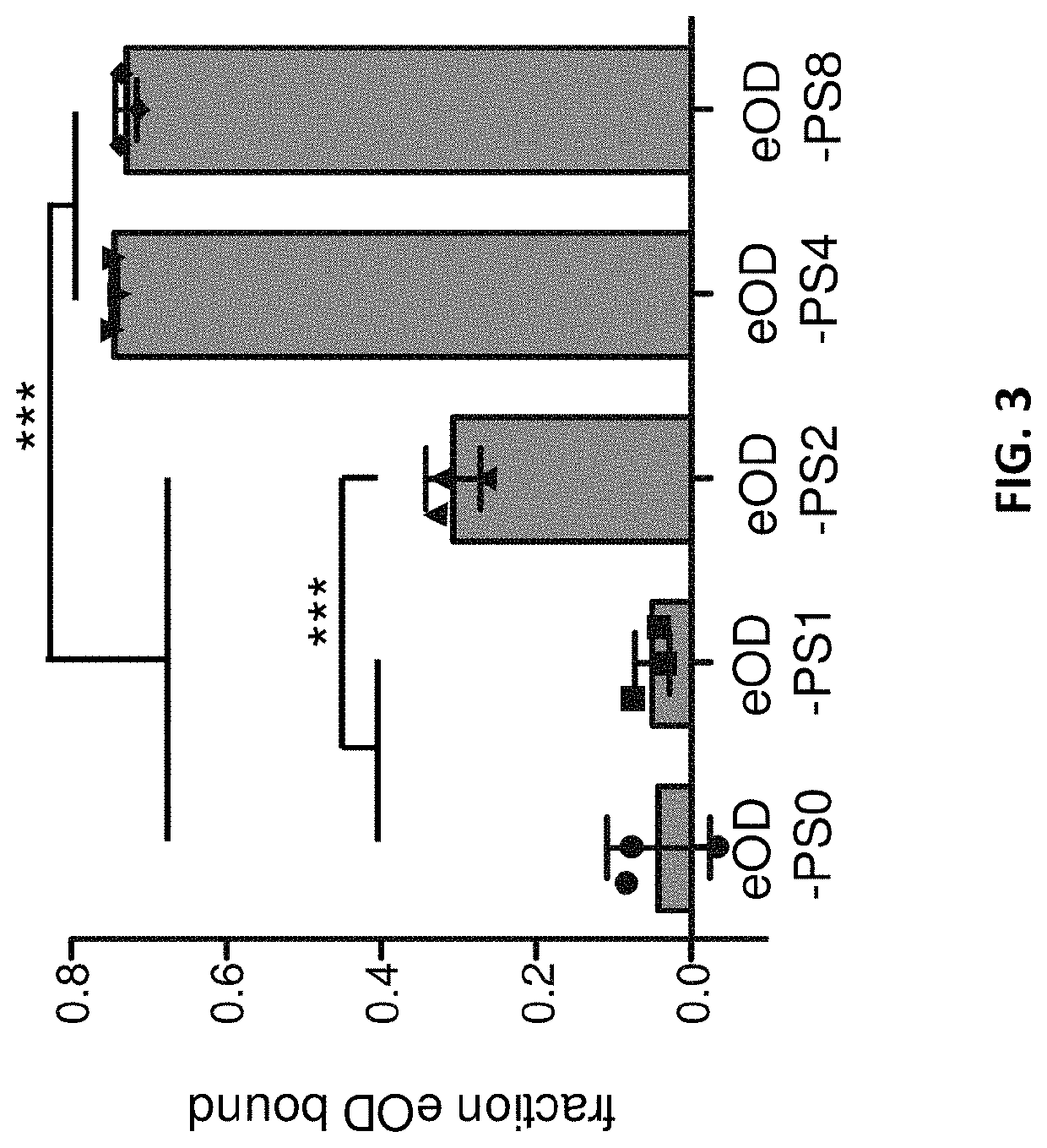Antigen-adjuvant coupling reagents and methods of use
a technology of antigen-adjuvant coupling and reagents, which is applied in the field of medical treatment, can solve the problems of unpredictable immune response effects and rapid desorption of antigens from alum particles, and achieve the effect of enhancing the immunogenicity of an antigen
- Summary
- Abstract
- Description
- Claims
- Application Information
AI Technical Summary
Benefits of technology
Problems solved by technology
Method used
Image
Examples
example 1
n of Protein Antigens to Alum Via a Multivalent Antigen-Adjuvant Coupling Reagent
[0295]Short peptide / polymer linkers that would mediate binding to alum by ligand exchange between phosphate groups and hydroxyls at the surface of alum particles were designed. Peptides comprised of 1-12 consecutive phosphoserines (PS) followed by a short poly(ethylene glycol) spacer and N-terminal maleimide functional group were prepared by solid phase synthesis.
[0296]FIG. 1A shows the chemical structure of maleimide-phosphoserine coupling reagents comprising phosphoserine linkers and a schematic of a protein antigen comprising a solvent-exposed, free sulfhydryl group (—SH). FIG. 1B shows the chemical structure of the maleimide-phosphoserine coupling reagent, wherein the maleimide moiety is covalently linked to a thiol group comprising a protein antigen via a thioether linkage. The final coupling reagent-antigen conjugate was mixed with alum in buffered saline, whereby the antigen was coupled or adsorb...
example 2
pecific B Cells Engulf Alum / PS-Antigen Nanoparticles and Exhibit Enhanced Activation In Vitro
[0301]Alum is not a monolithic solid but is made up of fibrous aggregates of aluminum hydroxide nanocrystals. Harris, J. R. et al. (2012) Micron 43, 192-200. In the setting of tight binding between the immunogen and alum particles, antigen delivery to lymph nodes over time could either be mediated by slow release of free antigen from alum surfaces at the site of injection, or antigen could be trafficked to lymph nodes still bound to aluminum hydroxide nanocrystals or nanocrystal aggregates, as shown in FIG. 6A. If the latter scenario were prevalent, this would have multiple implications for the immune response because (1) B cells are strongly triggered by multivalent particulate antigens, (2) alum particles might exert direct adjuvant activity on antigen-specific B cells, and (3) presentation of antigen from the particle surfaces could impact the epitope specificity of the humoral response.
[...
example 3
Coupled to Alum Via Multivalent Antigen-Adjuvant Coupling Reagents are Retained at Site of Administration and Enhance Anti-Antigen IgG Titers
[0303]PS-mediated binding to alum slows antigen clearance in vivo. Alum is retained at injection sites for many weeks, Flarend, R. E. et al. (1997) Vaccine 15, 1314-1318, but clearance of antigens administered with alum is often much faster. Gupta, R. K., et al., (1996) Vaccine 14, 1412-1416; Noe, S. M., et al., (2010) Vaccine 28, 3588-3594.
[0304]To test the effect of the coupling reagents in vivo, mice were administered AlexaFluor 647-labeled eOD antigen incubated with alum in the presence and absence of a multivalent coupling reagent comprising 4 phosphoserines (hereafter “PS4”). As a control, the eOD antigen and PS4 were incubated with Adju-Phos, an alternative aluminium-based adjuvant that does not bind to PS4. The fluorescent antigen-adjuvant formulations were injected subcutaneously at the tail base of BALB / c mice and monitored using an i...
PUM
| Property | Measurement | Unit |
|---|---|---|
| size | aaaaa | aaaaa |
| ka | aaaaa | aaaaa |
| pH | aaaaa | aaaaa |
Abstract
Description
Claims
Application Information
 Login to View More
Login to View More - R&D
- Intellectual Property
- Life Sciences
- Materials
- Tech Scout
- Unparalleled Data Quality
- Higher Quality Content
- 60% Fewer Hallucinations
Browse by: Latest US Patents, China's latest patents, Technical Efficacy Thesaurus, Application Domain, Technology Topic, Popular Technical Reports.
© 2025 PatSnap. All rights reserved.Legal|Privacy policy|Modern Slavery Act Transparency Statement|Sitemap|About US| Contact US: help@patsnap.com



